Smart homes are more popular now, offering convenience. But, it’s key to manage them well for the best performance. If you use smart gadgets for your home’s heating, lights, safety, or fun, managing them is crucial. This article will share tips on how to manage your smart home for the best results.
Having a smart home means more than just cool gadgets. It means taking care of your home’s smart systems so they work well. By using the right methods, you can make your home life better.1 This includes keeping your network in shape, updating your devices, and making your home secure. Stick with us to learn how to make your smart home the best it can be.
Figuring out how to manage your smart home might feel overwhelming. But, we’re here to guide you through making your devices work their best.1 In this article, you’ll get easy tips, key strategies, and learn why smart home devices are so awesome. Let’s dive in and see how you can turn your home into a smart, secure, and convenient place.1 Get ready to see your space in a whole new light.
Key Takeaways
- Assess your network infrastructure to ensure optimal performance and connectivity for your smart home devices.
- Regularly update your smart home devices to maintain security, functionality, and compatibility.
- Simplify your smart home system by evaluating essential devices and centralizing control for improved efficiency.
- Secure your smart home network to protect against external threats and unauthorized access.
- Automate your smart home configuration to enhance convenience, energy efficiency, and responsiveness.
Assess Your Network Infrastructure
The first step in improving your smart home is checking your network. Smart gadgets depend on a strong internet connection. This lets them talk to each other and your control center.2 For places with poor Wi-Fi, a mesh system can help by spreading the signal more evenly. This way, your smart gear works smoothly everywhere in your home.3 It’s key to make sure your network is up to the task for all those smart tools.
Evaluate Network Speed and Bandwidth
Online tools help in checking how fast and strong your Wi-Fi is in every room. Find spots where the signal drops, as they could cause issues.3 Wi-Fi 6 is a great new tech that offers better speed and can support many devices at once.3 Using mesh systems can remove weak signal problems, making your home fully connected.
Check Router Settings and Firmware Updates
It’s important to make sure your router is set up right for your smart gadgets.2 Choose routers that work well with Wi-Fi 6 for top performance.2 For a safer network, use WPA3 for protection and create a guest network.2 Keep all your devices’ software up to date for a smoother home network.
Identify Dead Zones and Signal Interference
Next, look at your home’s layout and the materials it’s made of. This helps find areas with poor Wi-Fi.3 To fix these, you might need to add more Wi-Fi points or a mesh system.3 A strong network means no room is left out of your smart setup.
Update Smart Home Devices Regularly
Keep your smart home safe and running smoothly by updating often.4 Manufacturers send updates and let you know when a device can’t be updated anymore. This means it’s time to get a new one.4 The latest smart locks and security cameras are much better. They use stronger tech for your peace of mind. And they have sharper video and more reliable alerts.4 New smart appliances can save more energy. They also help you manage food and even offer cooking tips thanks to AI. This shows how smart tech is always getting smarter.4
Enable Automatic Firmware Updates
Always check for device updates or set up alerts to remind you.5 Experts can watch over your devices online. They make sure everything’s working right and that updates are done when needed.5 Allowing remote updates keeps your network safer.5
Schedule Periodic Manual Updates
Set money aside for smart home updates yearly. Think about how old your devices are, the cost of new ones, and what they offer.4 Some brands let you trade in your old devices. This can get you a deal on new ones. It’s a green way to upgrade your tech.4 Know what’s new in the tech world. Sites like CNET, TechCrunch, and Wired can help. They talk about the latest trends and do reviews.4 Also, use online communities and platforms like YouTube, Reddit, and smart home forums. They’re full of advice, reviews, and talks about smart tech.4
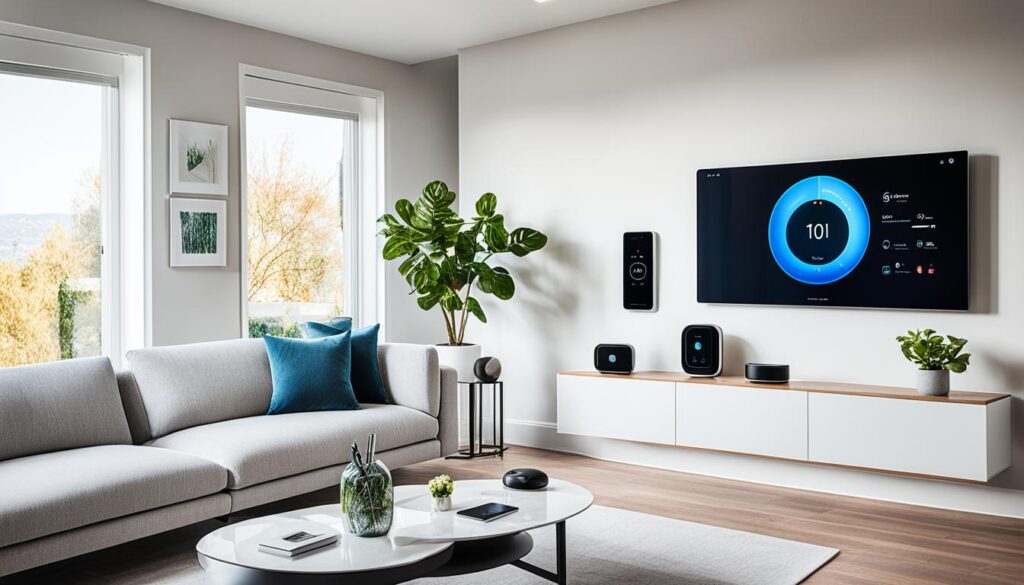
Simplify Your Smart Home System
As you add more smart home devices, keeping it simple is key to making it all work well.1 The third step is picking out what’s really important. Then, put them all in one place for easier control.
Evaluate Essential Devices and Features
Smart devices do a lot, which can make things confusing.1 Figure out what you need most. Get rid of what you don’t use to keep things clear and smooth.
Centralize Control with a Hub or Dashboard
Don’t use too many apps to manage your smart home gadgets.1 Pick a central system to bring everything together. This makes everything simpler, working better together.6 The Echo Hub lets you control all your smart gadgets from one place. It works with many smart home systems.
Making your smart home setup less complex can solve a lot of issues.6 Doing tasks automatically, like on the Echo Hub, can save you time and make your home smarter.
Secure Your Smart Home Network
Keeping our smart home safe is critical as we make our systems better. It’s easy to use but brings risks if not secured well.7 We’re going to look at ways to keep our smart home network safe and protect our data and privacy.
Use Strong Passwords and Encryption
Start with strong passwords to secure your smart home.7 Use long and complex passwords to stop hackers. Make them around 12 characters with a mix of letters, numbers, and symbols.7 Using WPA3 for Wi-Fi helps keep your network safe from outsiders too.8
Enable Firewalls and Antivirus Protection
It’s crucial to defend your devices from outside dangers.7 Add firewalls and antivirus to protect your network and devices. This stops malware and keeps your system safe.
Disable Unused Features and Services
Turning off what you don’t need can make your smart home safer.7 Unused features might become a way in for attackers. Regularly check your settings and turn off anything not in use.
Following these steps will make your smart home network much safer.8 Being proactive about security brings peace of mind. It lets you enjoy the perks of a smart home without worry.7
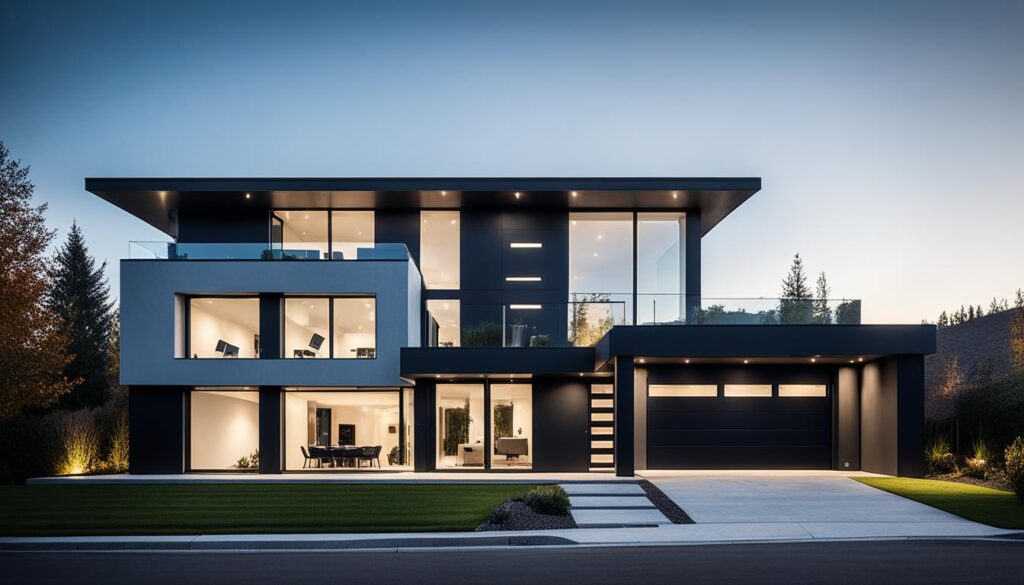
Automate Your Smart Home Configuration
The fifth step to better system performance is automation.1 Smart devices adapt to what you like and when you do things. They do this by using features like timers, sensors, and routines.1 By doing so, your home becomes both more efficient and responsive. You can also control it easier with voice commands or gestures. This makes your system save energy and time, which improves its overall performance.
Set Up Routines and Schedules
Smart home automation lets you create custom routines and schedules. This means setting your devices to do things in a certain order. For instance, a “Good Morning” routine can turn on lights, adjust the temperature, and brew coffee. This helps kick off your day smoothly. A “Goodnight” routine might lock doors and set the security system.1
Utilize Voice Commands and Gestures
Voice commands and gestures make controlling your home easier.1 With virtual assistants like Google Assistant or Amazon Alexa, you can control devices just by speaking. This touch-free control is both convenient and efficient. Some devices even respond to simple gestures. For example, waving your hand to turn off lights. This makes interacting with your smart home simple and hassle-free.
Monitor System Performance and Usage
Keeping your smart home running well is an ongoing job. You should regularly check how it’s working and being used. Smart devices help by giving you info on their status and how efficient they are. This info can show you where you can make things better. Using logs, reports, alerts, and analytics can let you closely watch how your system is doing. This helps to find and fix problems or ways to make it work better.
Analyze Logs and Reports
Smart home devices keep detailed logs and reports. These cover how they’re running, what’s stopping them, and other important details.9 Checking these logs and reports often can show you patterns and help fix issues. This makes your smart home work better, smarter, and more smoothly.
Set Up Alerts and Notifications
It’s a good idea to have alerts and notifications in place. They help you spot any problems early. This could be a , if it’s 2 standard deviations or more than a 5% drop.9 Getting these alerts means you can fix problems fast. This keeps your voice-controlled and IoT devices running smoothly.
Checking on your smart home’s performance and use is key to keeping it at its best. By using the data your devices provide, you can stay ahead of any issues. This allows you to make smart choices and keep your home as user-friendly as possible.
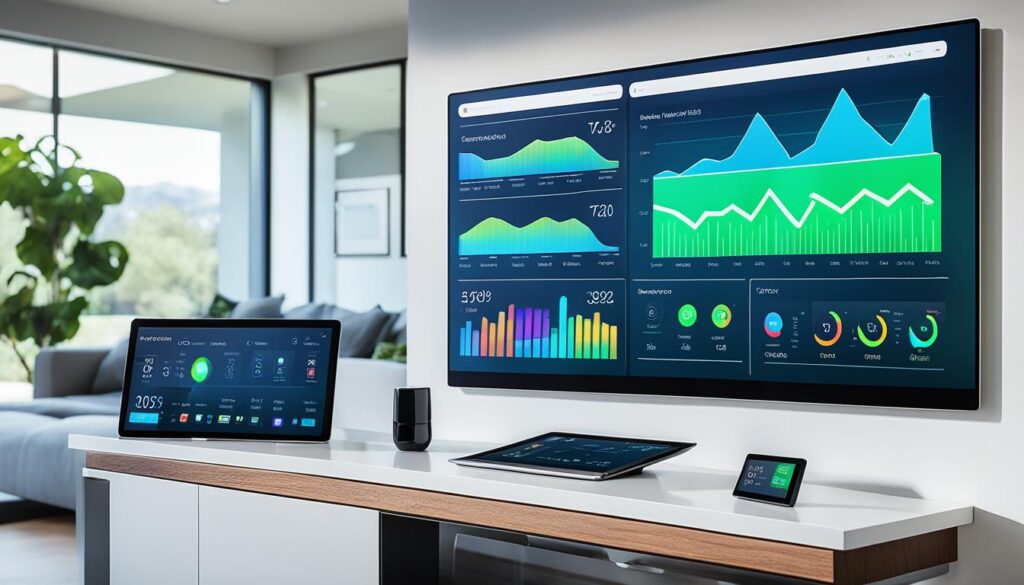
Optimize Network for Smart Home Devices
Having a strong network is key for your smart home to work well. Start by making sure Wi-Fi reaches all parts of your home.10 You might need mesh Wi-Fi or range extenders to boost the signal everywhere.10
Prioritize Quality of Service (QoS)
With a good network set up, focus on giving your important devices top priority.10 Things like security cameras need more bandwidth to work smoothly.10 This way, they won’t have connection problems or run slow.
Segment Devices Based on Usage
10 Use different SSIDs for smart and personal devices.10 This helps you manage your network better.10 Also, try putting devices on different Wi-Fi frequencies to cut down on interference.10
Making your network strong and smart will fix a lot of issues. Your devices will react better, and your smart home will be more useful. Plus, it’ll make life easier for you.
smart home configuration
Before starting, make a plan for your smart home setup. Think about which devices you’ll use and how they will work together.1 The main choices for smart home setups are Google Home, Amazon Alexa, and Apple HomeKit. They fit different needs and devices.1 Choose a central hub to be your smart home’s main control. Decide where to put sensors, switches, and other devices for the best use. This planning makes your smart home work well and be organized.
Plan System Architecture and Device Compatibility
When you add new devices to your smart home, make sure they work with what you already have.1 Look for logos that show which ecosystems the devices support. You might see Google Assistant, Alexa, or Apple HomeKit symbols. These logos show they can work together.1 Look online or ask other users to check if things will work together.
Consider Ecosystem Integration
1 Amazon Alexa works with the most different devices. It has many third-party Skills, making it a top choice for smart homes.1 Apple HomeKit is best for iPhone users who want a secure option. It makes connecting and using devices easy and focuses on privacy.1 Google Home is strong because of Google Assistant. It’s good at understanding different commands and works smoothly with Android. Think about which platform works best with your devices. Some platforms match with more third-party devices and services, offering more options for your smart home.
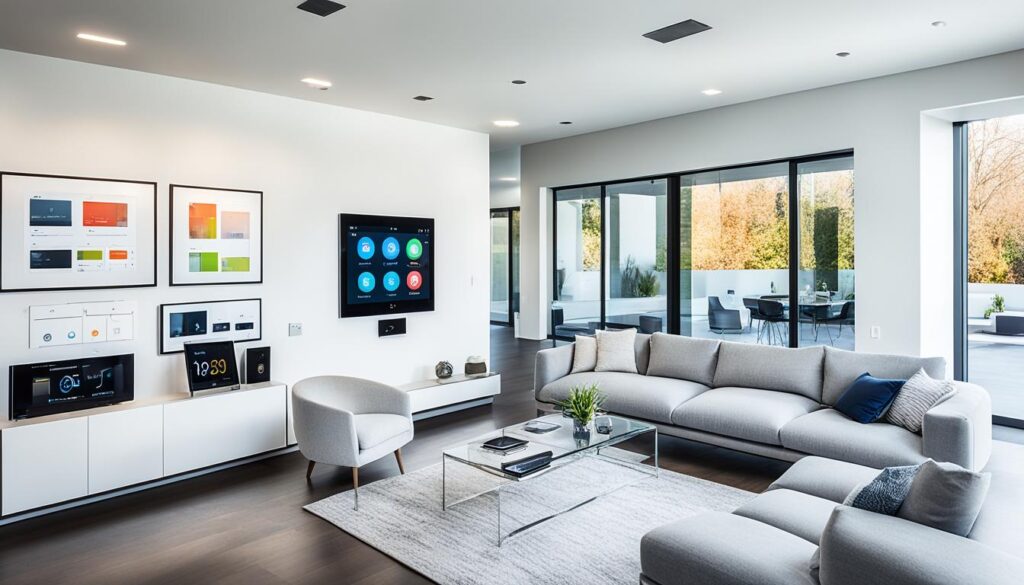
Maintain and Troubleshoot Your Setup
Keeping your smart home in top shape is vital. Make sure to check for updates often on all your smart devices.11 Set up automatic updates. This way, you get the newest features and security fixes.11 Don’t forget to review and adjust your security settings. It keeps your smart home safe.11
Perform Regular Maintenance Tasks
Keep an eye on your network traffic for odd patterns. It could help you catch security problems early.11 Also, watch how well your devices connect and perform. Make any needed changes for better use.11 Regularly update firmware, fix security issues, and tweak your network settings. This keeps your smart home running smoothly.
Diagnose and Resolve Issues
If something goes wrong, don’t wait to act.11 Use troubleshooting guides from manufacturers or online communities.11 Whether it’s a connection drop or a device not working, addressing problems early is key. It helps keep your smart home problem-free.
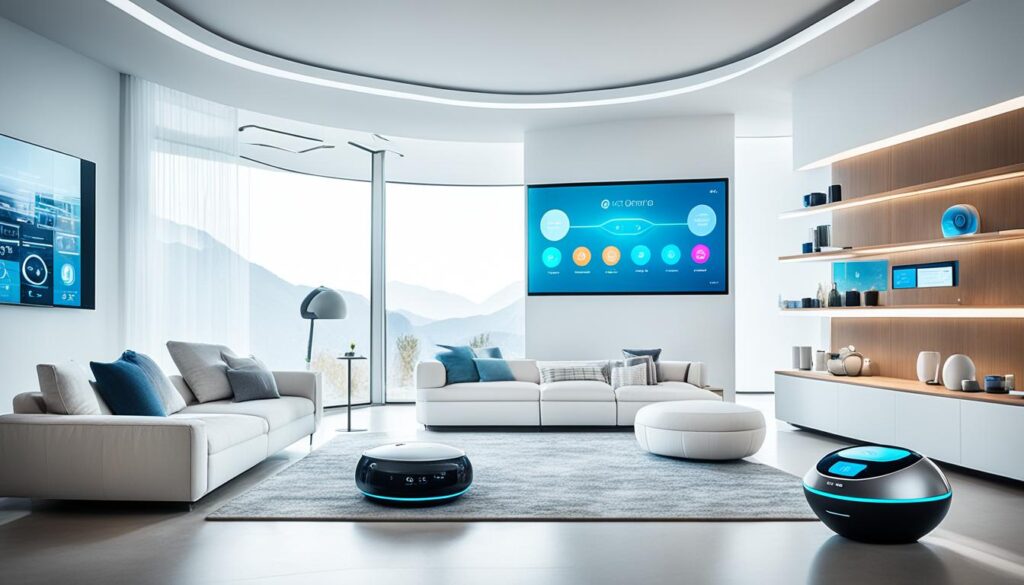
Conclusion
A well-configured smart home system does more than work well. It also makes your home safer. By putting your devices into groups and using the best methods for each, you get a smooth experience online. Plus, you keep your digital world safe.12 Spending time to set up your home network the right way will pay off. You’ll have quicker internet, better security, and peace of mind in our super-connected world.12
Start using home automation and see how it makes life easier, more comfy, and saves energy.12 Keep learning about the newest smart home technology to get the most out of your smart home system.12 Make sure to connect your IoT home integration and AI-powered home control smoothly. This way, you can make a smart living space that fits your needs and style.
To make your smart home a success, you need to manage your devices well. Also, it helps to understand how to use voice-controlled systems and intelligent house programming. Enjoy setting up your smart home and get the best out of your personalized home ecosystem.
FAQ
How can I optimize the performance of my smart home system?
First, check your network setup. Next, keep all devices updated. Also, make your system simpler and secure your network. Finally, add automation and regularly check how your system is doing.
Why is it important to evaluate my network speed and bandwidth?
It’s vital because all smart devices talk to each other over the network. High traffic can slow things down. So, check if your network can support all devices for smooth operation.
How often should I update my smart home devices?
Update your devices often. This keeps them working well and secure. Turn on auto-updates, and remember to check for updates too.
How can I simplify my smart home system?
Start by picking the essential devices and functions. Use a single hub or dashboard for easy control. Try not to use too many different apps.
What steps should I take to secure my smart home network?
Use strong passwords and encryption. Turn on firewalls and use antivirus. Also, turn off any features you don’t use, to protect your system against threats.
How can I automate my smart home configuration?
Setting up timers, sensors, and routines can automate tasks. This makes your system work better. You can control it with your voice, gestures, or shortcuts.
Why is it important to monitor my smart home system regularly?
By keeping an eye on your system, you can catch and fix issues. This also helps you make your system better over time. Monitoring with logs and alerts is key.
How do I ensure optimal network performance for my smart home devices?
Give more bandwidth to devices that need it most. Group your devices by their needs. This keeps your connection stable for all devices.
What should I consider when planning my smart home system architecture?
Think about the devices and how they will talk to each other. Have a central management hub. Plan where you’ll put sensors and switches for the best performance.
How do I maintain and troubleshoot my smart home setup?
Regularly clean and restart your devices. Keep an eye out for any issues, and fix them fast. This ensures everything works as it should.
Source Links
- https://www.wired.com/story/how-to-set-up-smart-home/
- https://hometechproguide.com/the-ultimate-guide-to-setting-up-your-smart-home-network/
- https://www.fiori.com.au/blogs/building-a-home-tips/building-a-connected-home-key-considerations-for-smart-home-setup
- https://www.nar.realtor/magazine/real-estate-news/technology/smart-home-tech-what-to-upgrade-and-when
- https://www.linkedin.com/advice/0/how-do-you-audit-update-your-smart-home-devices
- https://www.brandpointcontent.com/article/42833/4-ways-smart-home-technology-can-simplify-your-life
- https://www.mcafee.com/learn/how-to-secure-your-smart-home-a-step-by-step-guide/
- https://www.netgear.com/hub/technology/iot-device-security-home/
- https://developers.home.google.com/codelabs/monitoring-outages
- https://forum.openwrt.org/t/recommendations-for-iot-smarthome-network-optimization/100386
- https://www.nachi.org/problems-smart-home-tech.htm
- https://www.investopedia.com/terms/s/smart-home.asp
